Madhya Pradesh is a state located in the heart of India and is known for its rich culture, traditions, and heritage. One of the significant aspects of its cultural heritage is its folk dance, which reflects the diversity and richness of the state’s customs and rituals.
Moreover, the folk dance of Madhya Pradesh is an integral part of its social and cultural fabric, and it has been an essential medium of communication and expression for the people of the state.
The state’s folk dance is a reflection of the diversity and unity of its people, and it has a unique identity that sets it apart from other regions of India. Madhya Pradesh’s folk dances are a blend of religious, spiritual, and cultural influences, and they are performed on various occasions such as festivals, weddings, and social gatherings.
| Folk Dance | Region |
|---|---|
| Badhai | Bundelkhand, Malwa |
| Bhagoria | Jhabua, Alirajpur |
| Bhilmati | Malwa |
| Grida | Malwa |
| Jawara | Bundelkhand, Malwa |
| Kaksar | Malwa |
| Karma | Chhattisgarh, Shahdol, Rewa |
| Matki | Malwa |
| Muriya | Bastar, Dantewada |
| Rai | Bundelkhand, Malwa |
| Saila | Gwalior-Chambal, Bundelkhand |
| Selalarki | Malwa |
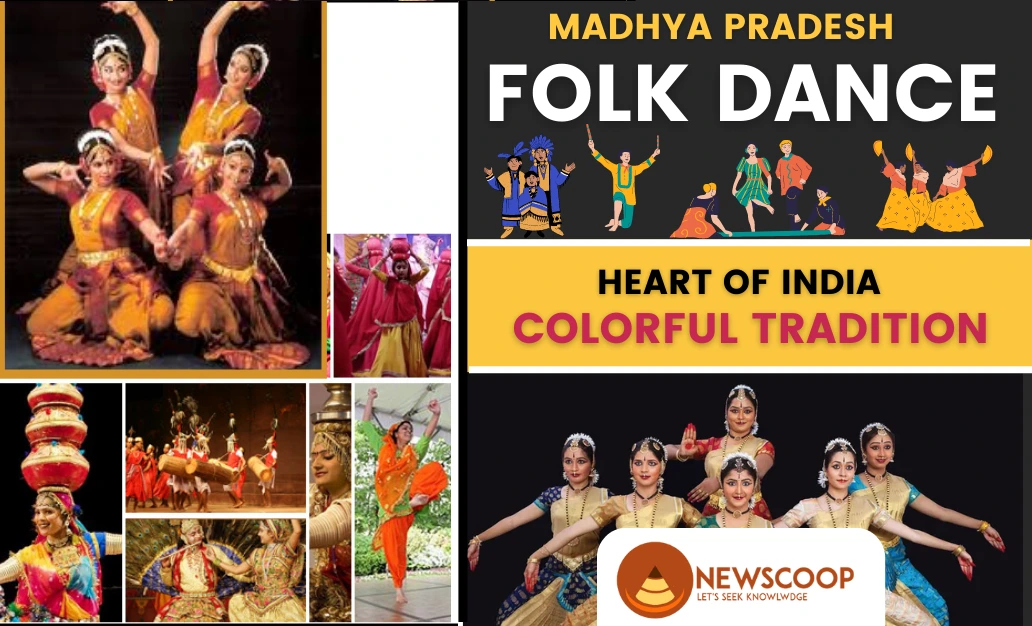
Introduction
Madhya Pradesh’s folk dance is an ancient art form that has been passed down from generation to generation. The state’s folk dance has been influenced by various factors such as the region’s topography, religion, traditions, and customs. The state’s folk dances are performed by both men and women, and they have a unique style and rhythm.
The folk dance of Madhya Pradesh is a celebration of life, and it reflects the joy, happiness, and unity of the people of the state. The state’s folk dances are performed with great enthusiasm, and they are a spectacle to behold. The folk dance of Madhya Pradesh is an essential part of its cultural heritage, and it has been recognized as a significant art form by various institutions and organizations.

Popular Folk Dance of Madhya Pradesh
Madhya Pradesh has a rich tradition of folk dances, and some of the popular folk dances of Madhya Pradesh are:
- Matki Dance
- Jawara Dance
- Gaur Dance
- Rai Dance
- Badhai Dance
- Bhagoria Dance
- Karma Dance
- Saila Dance
- Kaksar Dance
- Muriya Dance
- Grida Dance
- Bhilmati Dance
- Selalarki Dance
1. Matki Dance
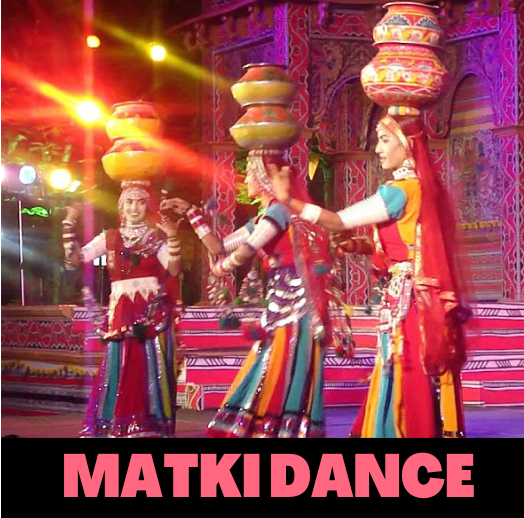
- Matki Dance is a popular folk dance of the Malwa region of Madhya Pradesh.
- The dance is performed during the festival of Holi, which is celebrated to mark the victory of good over evil and the arrival of spring.
- The Matki Dance is performed by women who balance earthen pots (Matkis) on their heads and form a human pyramid to reach and break a pot of curd hung high above.
- The dance symbolizes the love and devotion of Lord Krishna’s childhood friends, who would steal curd from the houses of their neighbors and share it with him.
- The dancers dress up in colorful costumes and jewelry and wear Ghungroos (anklets with bells) on their feet to add to the rhythm of the dance.
- The music for the dance is provided by instruments such as the Dhol, Nagada, and Manjira.
- The Matki Dance is not only an expression of joy and celebration but also a display of the strength, agility, and teamwork of the dancers.
- The dance is an essential part of the cultural heritage of Madhya Pradesh and is performed with great enthusiasm and fervor.
- The state government of Madhya Pradesh has taken various steps to promote and preserve the Matki Dance.
- The government has provided financial assistance to folk dancers and cultural institutions and has organized festivals and cultural events to promote the dance form.
- The Matki Dance is a unique and vibrant form of folk dance that showcases the rich cultural traditions of Madhya Pradesh and is a must-see for anyone visiting the state during the festival of Holi.
2. Jawara Dance
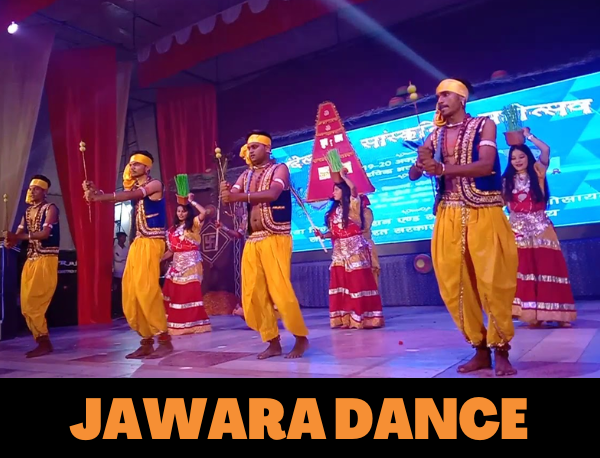
- Jawara Dance is a popular folk dance of the Bundelkhand region of Madhya Pradesh.
- The dance is performed during the harvest season and is also known as the “dance of the grain.”
- The dance is performed by men and women who form a circle and move in a circular pattern to the beats of the Dhol, Nagada, and Manjira.
- The dancers carry small heaps of Jawara (millet) in their hands, which they sprinkle on the ground as they dance.
- The dance is performed to express gratitude to the gods for a bountiful harvest and to seek their blessings for future harvests.
- The costumes worn by the dancers are simple and traditional, with men wearing dhoti-kurta and women wearing sarees or lehengas with dupattas.
- The dance is also accompanied by singing, and the songs sung during the dance are usually in praise of the gods and goddesses associated with agriculture and harvest.
- The Jawara Dance is not only a celebration of the harvest but also a symbol of community spirit, as it brings people together and fosters a sense of unity and harmony.
3. Gaur Maria
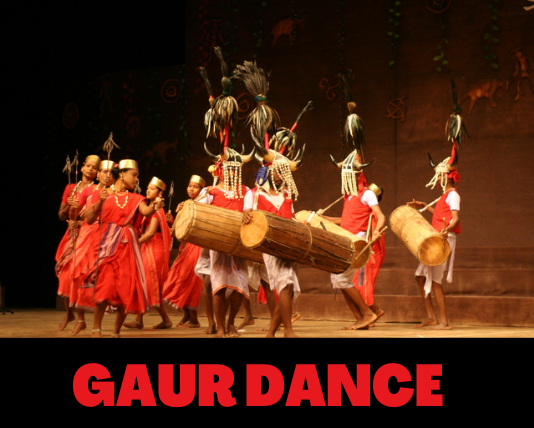
- Gaur Maria is a popular folk dance of the Gond tribes of Madhya Pradesh.
- The dance is performed during the festival of Holi and is also known as the “cow dance” or “Gauri dance.“
- The dance is performed by men and women who wear colorful costumes and ornaments made of beads, cowries, and shells.
- The dancers form a circle and move in a circular pattern to the beats of the Dhol, Nagada, and Manjira.
- The dance is accompanied by singing, and the songs sung during the dance are usually in praise of the goddess Gauri.
- The dance is a celebration of the coming of spring and the victory of good over evil, as represented by the story of the demon Holika and the god Krishna.
- The Gaur Maria dance is not only a celebration of Holi but also a symbol of the Gond culture and their deep reverence for nature and the cow.
4. Rai Dance

- The Rai community is mainly concentrated in the Nimar region(Bediya tribe) of Madhya Pradesh.
- The dance is usually performed during the Shravan month of the Hindu calendar, which corresponds to July-August.
- The dance steps are simple and energetic, with a lot of emphasis on jumping and hopping movements.
- The dancers usually wear bright and colorful costumes, with women wearing saris and men wearing dhotis and kurtas.
- The musical accompaniment for the dance is provided by traditional instruments like the Dholak and Nagada, which create a lively and energetic rhythm.
- Rai Dance is not just a form of entertainment, but also a way for the Rai community to come together and celebrate their culture and traditions.
5. Badhai Dance

- Badhai Dance is performed during various occasions such as weddings, childbirth, and festivals like Diwali and Holi.
- The dance is performed by a group of men and women. The dancers form a circle and move in a clockwise direction, with the men holding sticks and the women carrying pots on their heads.
- The musical accompaniment for the dance is provided by traditional instruments like the Dholak and Nagada.
- Badhai Dance is considered a ritualistic dance and is performed to seek blessings for the bride and groom or the newborn child and their family.
- The dancers wear colorful traditional attire, with the women wearing saris and the men wearing dhotis and kurtas.
- Badhai Dance has its origins in the Bundelkhand region of Madhya Pradesh and is also known as the “Badhai Ho” dance.
- The music for the dance is usually upbeat and lively, with a lot of emphasis on percussion instruments.
- Different variations of Badhai Dance are performed in different parts of Madhya Pradesh, with some variations incorporating acrobatics and sword fighting elements.
6. Bhagoria Dance
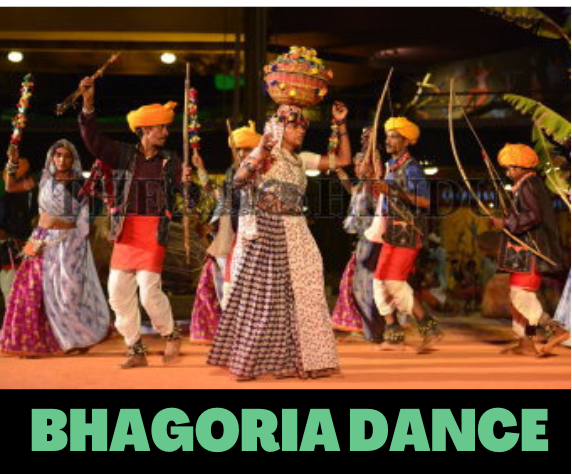
- Bhagoria Dance has its origins in the Bhil and Bhilala tribes of Madhya Pradesh.
- The dance is performed during the Bhagoria festival, which usually falls in the month of March.
- The dance is performed by men and women, who dance to the beat of traditional instruments like the Dhol and Manjira.
- The dancers wear colorful traditional attire, with women wearing ghagras and cholis and men wearing dhotis and kurtas.
- The dance symbolizes the celebration of love and romance, with young men and women using the occasion to express their love and affection for each other.
- The dance is also performed to seek blessings from the gods for a good harvest and a prosperous future.
- Different variations of the Bhagoria Dance are performed in different parts of Madhya Pradesh, with some variations incorporating acrobatic elements like somersaults and cartwheels.
- Bhagoria Dance is not just a form of entertainment, but also a way for the community to come together and celebrate their culture and traditions.
7. Karma Dance
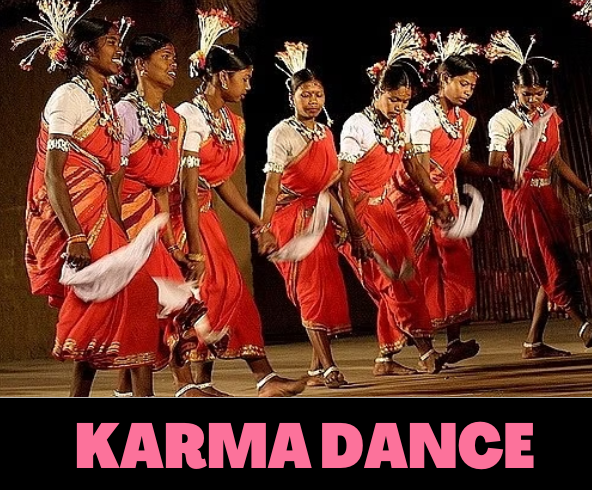
- Karma Dance has its origins in the Gond and Baiga tribes of Madhya Pradesh.
- The dance is performed during the Karma Festival, which is celebrated by the tribes in the month of August or September.
- The dance is performed to worship the Karam Devta, who is believed to be the god of wealth and health.
- The dance is performed by men and women, who dance in a circle while holding hands. The dancers move in a circular motion while singing and clapping to the beat of traditional instruments like the dhol and Jhanj.
- The dancers wear traditional attire, with women wearing colorful sarees and men wearing dhotis and kurtas.
- The dance symbolizes the spirit of community and brotherhood, with people coming together to celebrate the harvest season and seek blessings for a good crop.
- The dance is also performed to seek blessings from the Karam Devta for a prosperous future.
8. Saila Dance

- Saila Dance has its origins in the Pardhi tribe of Madhya Pradesh.
- The dance is performed to worship the goddess Saila, who is believed to protect the tribe from evil spirits.
- The dancers wear traditional attire, with women wearing colorful sarees and men wearing dhotis and kurtas.
- The dance symbolizes the unity and strength of the Pardhi tribe and their connection to the goddess Saila.
- Saila Dance is not just a form of entertainment, but also a way for the Pardhi community to come together and celebrate their culture and traditions. It plays an important role in strengthening community bonds and promoting social cohesion.
- Along with dhol and Nagada, the dancers also use other traditional instruments like shehnai, bansuri, and Maandar.
- The movements in Saila Dance are simple and graceful, with a focus on maintaining the rhythm and synchronization of the group.
9. Kaksar Dance

- Kaksar Dance has its origins in the Gond tribe, which is one of the largest tribal communities in central India.
- The dance is performed to celebrate various occasions such as harvest, weddings, and other festive events.
- The dance is performed in a group, with both men and women participating. The dancers move in a circle, with the lead dancer standing in the center and guiding the movements of the group. The dance is accompanied by traditional instruments such as the dhol and the Mandar.
- The dancers wear colorful and traditional attire, with women wearing sarees and men wearing dhotis and kurtas.
- Along with dhol and Mandar, other traditional instruments such as the shehnai and bansuri are also used in Kaksar Dance.
10. Muriya Dance

- Muriya Dance has its origins in the Baiga tribe, which is one of the most ancient tribes in central India.
- The dance is performed during various occasions such as weddings, harvest festivals, and other festive events.
- The dance is performed by both men and women, with the men playing drums and the women dancing in a circle. The dance is characterized by its energetic and rhythmic movements.
- The women wear colorful sarees and traditional jewelry, while the men wear dhotis and kurtas.
- Muriya Dance is symbolic of the harmony and unity of the Baiga tribe and is an expression of their collective joy and celebration.
- The dance is an important part of the Baiga tribe’s cultural and religious practices and is performed during various rituals and ceremonies.
- Musical instruments: The main musical instrument used in Muriya Dance is the drum, which is played by the male dancers. Other traditional instruments such as the bansuri and shehnai are also used.
11. Grida Dance
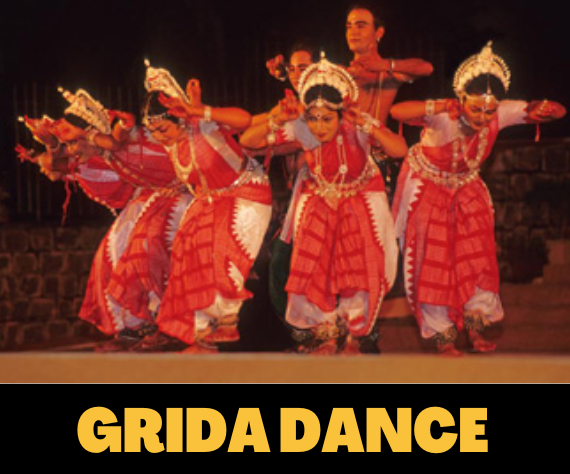
- Grida Dance has its origins in the Bhil tribe, which is one of the largest and most ancient tribes in central India.
- The dance is performed during various occasions such as weddings, harvest festivals, and other festive events.
- The dance is performed by both men and women, with the men playing musical instruments such as the dhol and shehnai, and the women dancing in a circle. The dance is characterized by its rhythmic movements and energetic footwork.
- The women wear colorful sarees and traditional jewelry, while the men wear dhotis and kurtas.
- Grida Dance is symbolic of the harmony and unity of the Bhil tribe and is an expression of their collective joy and celebration
- Efforts are being made to preserve and promote the Grida Dance, which is an important part of Madhya Pradesh’s rich cultural heritage.
- Grida Dance is not just a form of entertainment, but also a way for the Bhil community to come together and celebrate their culture and traditions. It plays an important role in strengthening community bonds and promoting social cohesion.
- The main musical instruments used in Grida Dance are the dhol and shehnai, which are played by male dancers. Other traditional instruments such as the Nagada and bansuri are also used.
12. Bhilmati Dance

- Bhilmati Dance has its origins in the Bhil community, which is one of the largest and most ancient tribes in central India.
- Performance: The dance is performed by both men and women, with the men playing musical instruments such as the dhol and Nagada, and the women dancing in a circle. The dance is characterized by its rhythmic movements and energetic footwork.
- The women wear colorful sarees and traditional jewelry, while the men wear dhotis and kurtas.
- Bhilmati Dance is not just a form of entertainment, but also a way for the Bhil community to come together and celebrate their culture and traditions. It plays an important role in strengthening community bonds and promoting social cohesion.
- The main musical instruments used in Bhilmati Dance are the dhol and Nagada, which are played by male dancers. Other traditional instruments such as the bansuri and shehnai are also used.
13. Selalarki Dance
- Selalarki Dance originated in the tribal regions of Madhya Pradesh and is believed to be an ancient dance form that has been passed down through generations.
- Selalarki Dance is usually performed by a group of 10 to 12 dancers, with both men and women taking part. The dance is characterized by its rhythmic movements and lively music.
- The dancers wear colorful traditional attire, which includes flowing skirts and bright turbans for the men. The women wear heavy jewelry, which is an integral part of the dance.
- The music for Selalarki Dance is provided by a variety of instruments, including the dholak, Nagada, and shehnai. The music is lively and upbeat and sets the tone for the dance.
- Selalarki Dance is an important part of the tribal communities’ social and cultural identity and is a way for them to come together and celebrate their traditions.
- Selalarki Dance has become a popular tourist attraction in Madhya Pradesh and is often performed at cultural festivals and other events. The dance has helped to promote the state’s rich cultural heritage and has become a source of pride for the tribal communities that perform it.

Importance of Folk Dance in Madhya Pradesh
The folk dance of Madhya Pradesh is an essential part of the state’s cultural heritage, and it plays a significant role in its social and cultural fabric. The folk dance of Madhya Pradesh is not just a form of entertainment, but it is also a medium of communication and expression for the people of the state.
The folk dance of Madhya Pradesh is significant because it reflects the region’s customs, traditions, and values. The folk dance of Madhya Pradesh is a way of preserving the region’s culture and passing it on to future generations. The folk dance of Madhya Pradesh is also significant because it promotes social harmony and unity among the people of the state.
Impact of Folk Dance on Madhya Pradesh’s Society and Economy
The folk dance of Madhya Pradesh has a significant impact on the state’s society and economy. The folk dance of Madhya Pradesh is an essential aspect of the state’s cultural heritage, and it attracts tourists from all over the world. The folk dance of Madhya Pradesh has contributed to the state’s economy by generating employment opportunities for people involved in the tourism and hospitality industry.
The folk dance of Madhya Pradesh has also had a positive impact on the state’s society. The folk dance of Madhya Pradesh promotes social harmony and unity among the people of the state. The folk dance of Madhya Pradesh has also contributed to the state’s education system by providing a platform for students to learn about the region’s culture and traditions.
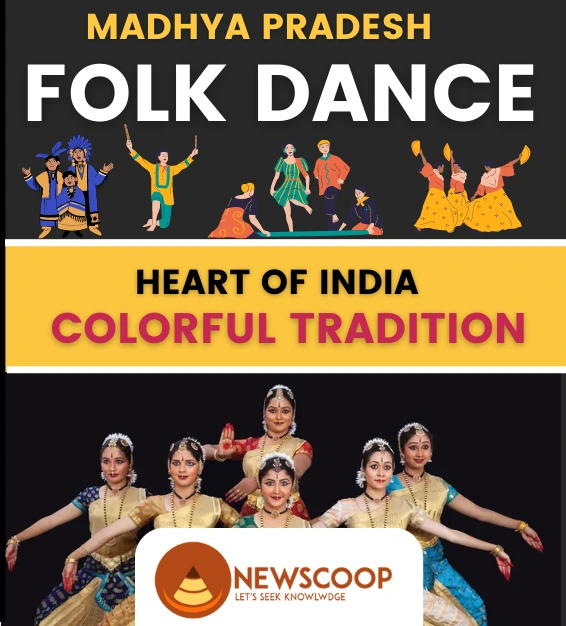
Also Read: Food Preservation Commission
Summary
Madhya Pradesh’s folk dance is an essential part of the state’s cultural heritage. The folk dance of Madhya Pradesh reflects the region’s customs, traditions, and values. The folk dance of Madhya Pradesh is not just a form of entertainment, but it is also a medium of communication and expression for the people of the state.
The preservation and promotion of Madhya Pradesh’s folk dance are crucial to maintaining the state’s cultural heritage. The state government has taken various steps to promote and preserve the folk dance of Madhya Pradesh. These steps include organizing festivals and cultural events, setting up cultural institutions, and providing financial assistance to folk dancers and cultural institutions.
In conclusion, the folk dance of Madhya Pradesh is a beautiful art form that reflects the region’s rich cultural heritage. It is an essential part of the state’s social and cultural fabric and plays a vital role in promoting social harmony and unity among the people of the state.
Thank You!
What is Folk Dance?
Folk dance is a form of traditional dance that originates from a particular cultural or ethnic group. It is usually passed down through generations and is an integral part of the community’s cultural heritage
How many types of folk dances are found in Madhya Pradesh?
Madhya Pradesh is home to more than 20 types of folk dances, each having its unique style, costumes, and traditions.
What is Rai folk dance in Madhya Pradesh?
Rai is a popular folk dance form in the Malwa region of Madhya Pradesh, India. It is primarily performed by the Rai community, who are known for their unique dance style.
Which is the famous dance of Madhya Pradesh State?
The famous dance of Madhya Pradesh, a state in central India, is called the “Tribal Dance” or “Gond Dance.” The Gond tribe, which is native to the region, is known for its vibrant and energetic dance forms.
Related Links:





